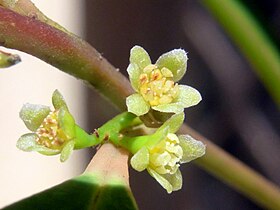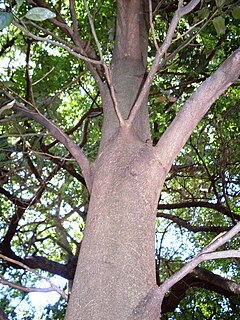
Cryptocarya foetida is a rainforest tree growing at the eastern coastal parts of Australia. The common name is due to the allegedly offensive odour given by the flowers. The stinking cryptocarya or stinking laurel is considered vulnerable to extinction with a ROTAP rating of 3VC.

Cryptocarya microneura is a rainforest tree growing at the eastern coastal parts of Australia.

Cryptocarya rigida is a small tree or shrub growing in high rainfall areas in north eastern New South Wales, Australia. It was described in 1864 by Carl Meissner in Prodromus Systematis Naturalis Regni Vegetabilis. Extinct in the Illawarra region, allegedly seen in the Illawarra in 1818 by Allan Cunningham.

Cryptocarya glaucescens, commonly known as jackwood, is a rainforest tree of the laurel family growing in eastern Australia.

Endiandra sieberi, known as the corkwood is a rainforest tree growing in eastern Australia.

Cryptocarya obovata is a species of laurel growing on basaltic and fertile alluvial soils in eastern Australian rainforests. It is found from Wyong in New South Wales to Gympie in the state of Queensland. Extinct in the Illawarra region, allegedly seen in the Illawarra in 1818 by Allan Cunningham. The species was included in the Prodromus Florae Novae Hollandiae et Insulae Van Diemen, 402 (1810)

Citronella moorei is a rainforest tree growing in eastern Australia. Common names for this species include churnwood, citronella, soapy box, silky beech, and corduroy.
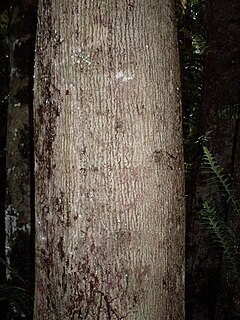
Emmenosperma alphitonioides, the yellow ash or bonewood, is a rainforest tree of eastern Australia. It grows from Clyde River, New South Wales near Batemans Bay, to Cape York Peninsula in at the most northerly part of Australia. It grows in many different types of rainforest, in tropical, sub tropical and warm temperate rainforests.

Cryptocarya laevigata, known as the glossy laurel or red-fruited laurel, is a rainforest plant growing in eastern Australia. The natural range of distribution is rainforest understorey on fertile soils, from the Richmond River, New South Wales to Cairns in tropical Queensland. Often seen in association with the White Booyong.

Cryptocarya foveolata, known as the mountain walnut is a rainforest tree growing at high altitude in eastern Australia. Despite the common name, it belongs to the laurel family.

Cryptocarya triplinervis is a rainforest tree growing in eastern Australia. Common names include the three veined laurel, three veined cryptocarya and the brown laurel.

Notelaea venosa is a very common shrub or small tree in eastern Australia. Occurring in or adjacent to rainforest from Lakes Entrance, Victoria to Cunninghams Gap in south eastern Queensland. Common names include veined mock-olive, smooth mock-olive, large-leaved mock-olive and large mock-olive. Often seen in the bushland areas in Sydney.

Maytenus silvestris is a shrub or small tree growing from Picton, New South Wales near Kroombit Tops, near Gladstone, Queensland. It occurs in dry rainforest, eucalyptus and rainforest ecotone areas. Common names include narrow leaved orangebark, orange bush and orange bark.

Cryptocarya bidwillii, the yellow laurel, is a small to medium-sized tree in the laurel family. Occurring in Australian rainforests from Nymboida in the state of New South Wales to Townsville in tropical Queensland. Often found in the dryer ridges in dry rainforest or in viney scrubs.
Cinnamomum virens is a rainforest tree growing in the eastern coastal parts of Australia. Common names include red-barked sassafras, black sassafras, camphorwood, scentless cinnamon wood, and native camphor laurel. Its habitat is between the Williams River and the Main Range National Park in Queensland. Growing in rich volcanic soils or on the poorer sedimentary soils, it is often in association with coachwood.

Endiandra compressa, the white bark, is a rainforest tree growing in eastern Australia. The habitat is rainforest growing near streams in valleys. The range of natural distribution is from the Nambucca River, New South Wales to Kutini-Payamu National Park, in north Queensland.
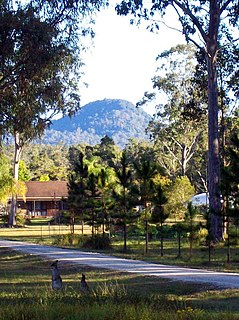
Cryptocarya floydii is an Australian rainforest tree. It occurs in steep dry rocky gullies in northern New South Wales and adjacent areas in Queensland as far north as Bunya Mountains National Park. It grows as far south as the upper gullies of the Guy Fawkes River and the Macleay River. The common name is gorge laurel or Glenugie laurel, after the type locality of Glenugie Peak, near Grafton, New South Wales.

Cryptocarya nova-anglica, the mountain laurel, is a rainforest tree growing in eastern Australia. The habitat is a restricted distribution in cool temperate rainforest mostly over 1,100 metres (3,609 ft) in altitude. The range of natural distribution is from the upper Hastings River to near the border of the state of Queensland. It is an understorey tree, associated with the Antarctic beech, possumwood, golden sassafras and black olive berry trees.
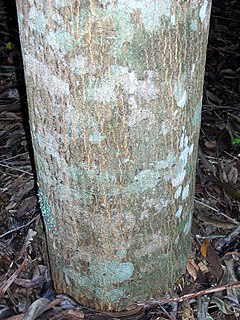
Owenia cepiodora is a medium to large Australian tree in the family Meliaceae. It occurs in the rainforests of north eastern New South Wales and adjacent areas in Queensland. The habitat is mostly the drier Hoop Pine rainforests along the state border. Only small regrowth trees remain, as it was heavily logged in earlier times. Its status is now considered vulnerable with a ROTAP rating of 2VCi.
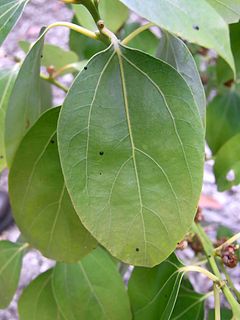
Neolitsea australiensis, also known as the green bolly gum, is an Australian rainforest tree, in the laurel family. The specific epithet is derived from "Australia", and the Latin "ensis"; meaning "native of Australia".

